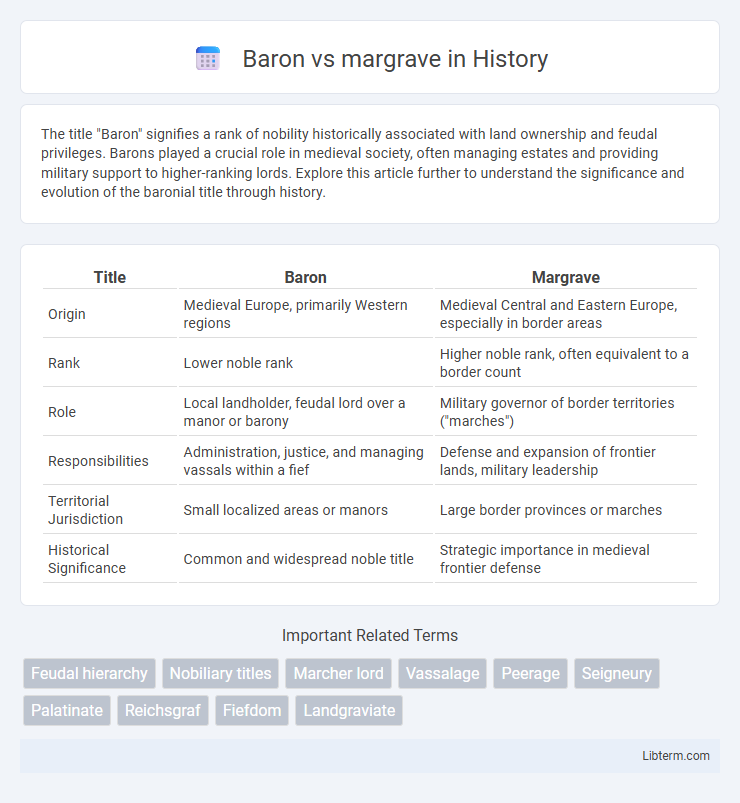The title "Baron" signifies a rank of nobility historically associated with land ownership and feudal privileges. Barons played a crucial role in medieval society, often managing estates and providing military support to higher-ranking lords. Explore this article further to understand the significance and evolution of the baronial title through history.
Table of Comparison
| Title | Baron | Margrave |
|---|---|---|
| Origin | Medieval Europe, primarily Western regions | Medieval Central and Eastern Europe, especially in border areas |
| Rank | Lower noble rank | Higher noble rank, often equivalent to a border count |
| Role | Local landholder, feudal lord over a manor or barony | Military governor of border territories ("marches") |
| Responsibilities | Administration, justice, and managing vassals within a fief | Defense and expansion of frontier lands, military leadership |
| Territorial Jurisdiction | Small localized areas or manors | Large border provinces or marches |
| Historical Significance | Common and widespread noble title | Strategic importance in medieval frontier defense |
Introduction to Noble Titles: Baron and Margrave
Baron and margrave are distinct noble titles used in European feudal systems, with baron representing a lower-ranked noble who typically held land directly from the king, while margrave referred to a military commander governing border territories known as marches. The title of baron signified basic noble status with administrative and judicial responsibilities within a shire or manor, whereas a margrave held greater authority and military duties, often tasked with defending frontier regions against external threats. Both titles embodied hierarchical roles within medieval aristocracy, reflecting the political and military organization of feudal societies.
Historical Origins of the Baron and Margrave
The historical origins of the baron trace back to the medieval feudal system, where barons were powerful landowners granted titles by monarchs in Western Europe, particularly England and France. Margraves emerged from the military frontier zones of the Holy Roman Empire, tasked with defending border territories known as marches, combining noble status with military authority. While barons primarily held localized authority over estates, margraves wielded strategic influence in territorial defense and governance during the early Middle Ages.
Etymology of Baron vs. Margrave
The term "Baron" originates from the Old French word "baron," derived from the Late Latin "baro," meaning "man" or "servant," and was historically used to denote a noble ranking just below a viscount. "Margrave" stems from the German "Markgraf," combining "Mark" meaning "border region" and "Graf" meaning "count," indicating a military governor responsible for defending frontier territories in the Holy Roman Empire. While "Baron" emphasizes noble status rooted in feudal hierarchy, "Margrave" reflects a specific territorial and military role tied to border defense.
Geographic Distribution of Barons and Margraves
Barons primarily held territories in Western Europe, especially in England, France, and Germany, where they governed smaller feudal estates within the kingdom's core regions. Margraves were more common along the eastern frontiers of the Holy Roman Empire, such as in Brandenburg and Austria, where they managed borderlands or marches to defend against external threats. This geographic distinction reflects the barons' role in internal administration versus the margraves' strategic responsibility for frontier defense.
Hierarchical Differences: Baron vs. Margrave
Barons rank lower than margraves in the feudal hierarchy, with barons typically governing smaller territories and owing allegiance to higher nobles. Margraves hold a more prominent military and administrative role, often governing border provinces known as marches to defend the realm. The distinction reflects differing responsibilities and statuses within medieval European nobility, where margraves exercised greater authority and strategic importance.
Roles and Responsibilities: Baronial vs. Margravial Duties
Barons primarily managed local estates, overseeing justice and administration within their baronies, acting as vassals to higher nobility while maintaining military support obligations. Margraves, appointed to govern border territories or marches, held enhanced military and administrative authority to defend frontier regions and enforce frontier law, often exercising greater autonomy than barons. The distinction in duties reflects the margrave's strategic responsibility for frontier defense compared to the baron's focus on internal estate management and feudal governance.
Power and Influence: Comparing Authority
Barons typically held authority over smaller territories with limited military and administrative influence, operating as vassals under higher nobles such as dukes or counts. Margraves wielded greater power, governing border regions known as marches with enhanced military responsibilities and autonomous command to defend against external threats. The margrave's authority often surpassed that of a baron due to their strategic roles and expanded jurisdiction, making them pivotal figures in medieval feudal hierarchies.
Baron and Margrave in Heraldry and Symbolism
In heraldry, a Baron traditionally symbolizes feudal authority with a simple escutcheon often adorned with minimal charges, representing loyalty and service within a defined territory. A Margrave, historically a military commander of a border province, is depicted with more elaborate heraldic elements, including marks of territorial defense and governance, signifying both noble rank and martial responsibility. The distinction in symbolism highlights a Baron's role within internal feudal hierarchy, contrasted with the Margrave's greater autonomy and strategic importance on frontier borders.
Modern Usage and Legacy of the Titles
Baron remains a widely recognized noble title primarily used in countries with a British influence, often signifying the lowest rank of the peerage and sometimes used in modern corporate or ceremonial contexts. Margrave, historically a military governor of a border province in the Holy Roman Empire, has largely fallen out of contemporary use but endures in historical and genealogical references, particularly in German-speaking regions. Both titles retain prestige in heraldic traditions, with barons frequently appearing in modern peerage systems, while the margrave title symbolizes territorial authority and defense legacy in medieval Europe.
Conclusion: Key Distinctions Between Baron and Margrave
Barons held a lower noble rank typically responsible for managing smaller landholdings, whereas margraves governed larger border territories with military and administrative authority. Margraves often had elevated status due to their strategic roles defending frontier regions, which granted them more autonomy than barons. Understanding these distinctions clarifies the hierarchical and functional differences within medieval European nobility.
Baron Infographic

 libterm.com
libterm.com